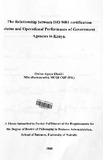| dc.description.abstract | The objectives of this research were to determine the relationship between ISO 9001:2008 standard certification status and operational performance of government agencies in Kenya, the extent the levels of adoption of the implementation factors influence that relationship, and to develop a theoretical framework to explain the relationships involved. An outcome thinking view was applied in examining the behavioral input factors prescribed by the ISO 9001 quality management system standard. Each of the factors was evaluated on the extent of alignment to the fundamental principles of quality management that underpin the management system standard.
Various statistical analyses were conducted on the secondary and primary data obtained from 47 government of Kenya owned organizations selected randomly. Quantitative data was obtained from 6 to 14 informants from each organization using a self-administered questionnaire. A cluster analysis was completed to develop a taxonomy of the participating organizations based on the standard’s implementation factors and organizational system outcome variables, finally regression analysis was completed to develop a theoretical framework of the concepts in involved.
The results of the study demonstrate that the ISO 9001 management system standard’s prescribed practices of quality policy and management review are the key enablers of performance both in the internal and external focus. The study finds that performance drivers in an organization are the ISO 9001 management system standard prescribed practice of quality objectives and the organizational system outcomes of customer focus and process approach. According to the results, it is through these performance drivers that the enablers of performance help achieve performance objectives.
The main contribution of this study has been to develop a theoretical framework to explain the inconsistencies in findings of certification/performance relationship studies and some paradoxes relating to ISO 9001 management system adoption. The theoretical framework helps characterize organizations and show how alignment of the adoption to the organizations’ strategic objectives enables organizations to achieve their goals using the management system framework.
The conclusion drawn from the study is that the framework provided by the ISO 9001 management system standard can help optimize operational performance when the prescribed practices are applied appropriately. Another conclusion is that observed cases of certification leading to reduction of performance are due to the effects of minimalist adoption approach with focus on iconic objectives.
As opposed to many studies that are based on problem/solution thinking approach, this study sheds light on why some organizations are reported to perform poorly after certification by adopting the outcome thinking approach to understanding how the framework is able to enhance performance. This approach has lead to a more comprehensive examination of the quality management standard adoption and what makes some certified organizations fail to achieve the intended goals of certification. The study achieves this objective by examining the standard’s behavioral inputs, their organizational system outcomes and how they relate to the internally and externally focused output performance outcomes. | en_US |



